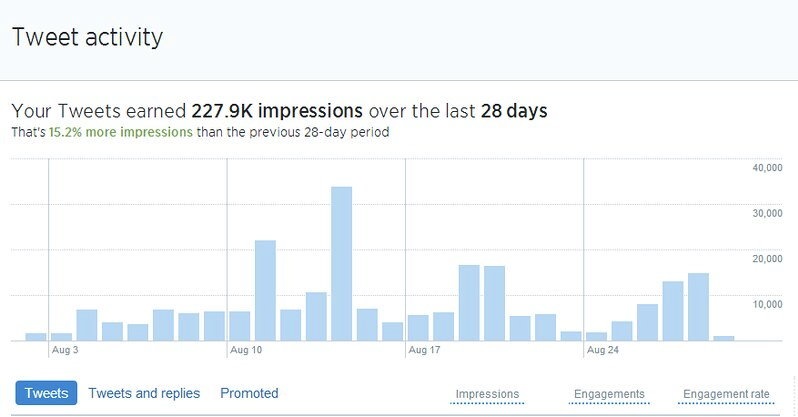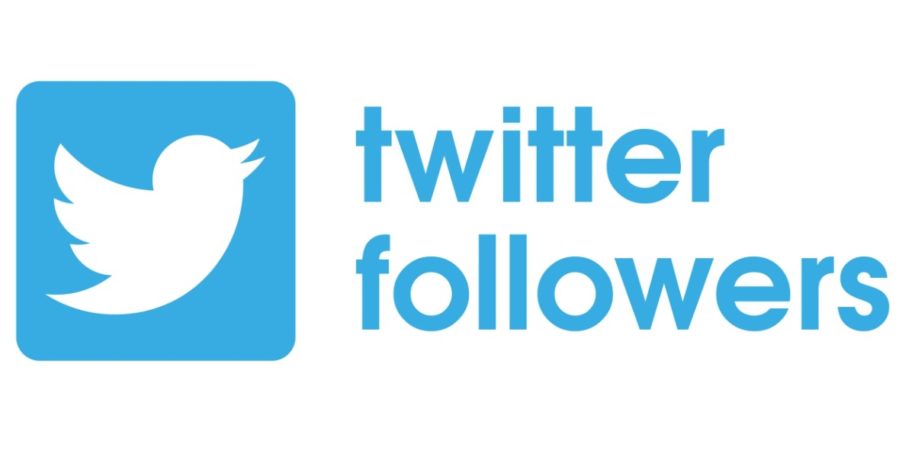Twitter provides you with a variety of metrics for tracking your social media marketing. One of the most useful metrics is your Twitter follower growth rate. Your follower growth rate gives you a general idea of the effectiveness of your strategies. It lets you know whether your audience is growing or shrinking. If your growth rate stalls or declines, you may need to rethink your marketing tactics.
So, what is your Twitter follower growth rate? It is the ratio of new followers to old followers. Calculating your growth rate is easy. You simply divide current followers by your follower count from any period and multiply the result by 100.
Twitter also offers real-time stats through Twitter Analytics. It displays the growth rate for the past 28 days and allows you to change the time frame. Use the following guide to track Twitter follower growth and improve your Twitter campaigns.
Want to save time and gain real Twitter followers? Our set it and forget it methodology for organic growth ensures you consistently get the results you’re looking for, without the hassle. Start targeting and attracting followers.
Table of Contents
Why Should You Track Your Twitter Follower Growth Rate?
Tracking your follower count over time provides a snapshot of the success of your social media marketing efforts. You can use the insight to grow more followers. Attracting more Twitter followers helps with brand awareness and online visibility.
Here a few of the benefits of paying attention to follower growth rate:
- Track the performance of Twitter campaigns
- Identify your best and worst content
- Improve engagement rates
- Discover the interests of your audience
- Find the top influencers in your industry
You can use the growth rate to track Twitter performance. For example, you can use analytics to determine when the rate of new followers slowed and review the tweets from around that period. You may identify the tweets that underperformed and avoid repeating the same mistakes.
Along with identifying content that performed poorly, you can identify the best-performing content with the highest engagement rates. Try to recreate the success of past tweets to keep growing your audience. Paying attention to changes in the growth rate also helps you analyze the interests of your audience. The tweets that receive the most shares and retweets likely discuss topics that your audience is interested in, which lets you know where to focus your future Twitter campaigns.
Reviewing the growth rate of your follower count also helps you find the top influences in your niche market. Influencer marketing tends to result in higher conversion rates, making it an effective way to attract more followers and increase your reach.
Important Twitter Analytics Metrics to Track
Along with follower growth rates, track the following tweet activity and Twitter metrics for more insight into the effectiveness of your marketing:
- Top tweet
- Top follower
- Profile visits
- Mentions
- Engagement rate
- Impressions
- Video completion rate
The top tweet is the most important metric. It is the tweet with the most likes, retweets, shares, and replies. This may include standard tweets and Twitter ads. Always pay attention to the top tweet to understand the type of content that your audience is most likely to respond to.
The top follower metrics make it easier to find influencers that follow your Twitter accounts. Working with influencers helps you reach more Twitter users, which should increase your growth rate. Tracking the total number of profile visits over time lets you know whether your brand awareness is increasing. The “mentions” metric gives you a better idea of your brand recognition. An increase in total mentions indicates that more people are talking about your brand.
You can also review the engagement rates of individual tweets. The tweet’s engagement rate is determined based on engagements divided by impressions. Along with your top tweet, you can gain valuable insight by analyzing the impact of each tweet from your account.
Twitter Analytics displays the total impressions for individual tweets and the total impressions for your entire account. The cumulative impressions for your account allow you to determine whether your reach is increasing.
The video completion rate provides insight into whether people are enjoying your video content. Find the videos with the highest completion rates to determine what type of video content to produce.
How to Use Twitter Analytics to Track Follower Growth
Sign in to your Twitter account use Twitter Analytics to track follower growth. Go to your profile and click on the profile picture. Select “Analytics” to view the most up-to-date metrics. Track the follower growth rate each week. If you continue attracting new followers each week, you should avoid tweaking your social media strategies too much. Stick with what works if you do not notice signs of a slowdown.
If new follower growth stagnates, use the following steps to expand your audience:
- Review additional metrics
- Use third-party tools
- Analyze your best-performing content
These same steps can also help you improve the success of social media campaigns on other platforms. After building your Twitter follower base, you can repeat the same steps to gain followers on Facebook, Instagram, or any other social media network.
1. Review Additional Metrics

Twitter users agree to allow the company to use cookies for purposes including analytics personalization and ad personalization. Analytics personalization and ads personalization allow Twitter to gather useful demographics data.
From Twitter Analytics, click on the “Followers” tab. The columns labeled “Most Unique Interests” and “Top Interests” help you determine what type of content your followers find most engaging.
2. Use Third-Party Tools to Gain More Information

Twitter Analytics only provides data for your profile. You may need to use third-party tools to check out your competition or gain more information about your Twitter account.
Here are a few of the best Twitter analytics tools for tracking follower growth and other Twitter metrics:
- FollowerAudit
- FollowersAnalysis
- FollowerWonk
- Hootsuite
- Buffer
The first three options are designed specifically for tracking Twitter metrics. FollowerAudit includes advanced tracking features, including real-time metrics. FollowersAnalysis can be used to track any public Twitter account, including your competition’s account.
FollowerWonk includes access to useful metrics for free. However, tracking and sorting followers requires a paid plan.
Hootsuite is also free to use and includes paid features. With a free account, you can track social media marketing campaigns across multiple social channels, including Facebook and Instagram.
Buffer is primarily used to schedule social media posts. However, it also includes metrics for monitoring and tweaking your campaigns.
3. Analyze Your Best-Performing Content

Examine the increase or decrease of followers over time to identify your best-performing content. The content that performs best often coincides with an increase in followers and engagement. You can also review the engagement rates of each tweet during a period of increased follower growth.
Try to assess the qualities that make your top tweets stand out compared to underperforming tweets. Pay attention to the following factors:
- The topic of the tweet
- The total character count of the tweet
- The day and time that the tweet was sent
- The type of content (image, video, or text)
You may find that the tweets with the highest engagement rates tend to discuss specific topics. These topics may also match the top interests of your audience, which you can find under the “Followers” tab of Twitter Analytics.
The total length of the tweet may also influence engagement rates. For example, your followers may tend to scroll past lengthy tweets.
Tweets also perform better during a certain time of day or specific days of the week. Twitter is often more active on Wednesdays, Thursdays, and Fridays. However, these trends vary based on your audience, which is why you should review the day and time of top-performing tweets.
Certain types of content may also reach more people. While video content is typically the most popular you may find that your tweets containing images or text also perform well.
Build Your Strategy Around What Works
After analyzing your best tweets, you should have a better idea of how to craft more engaging tweets. Build your future posting strategy around the qualities that you uncover when reviewing your top content.
Along with repeating your past success, you may find inspiration from your competition. Keep track of how tweets from your competition perform compared to your tweets. Reviewing your competition helps you uncover strategies that you may have overlooked.
Continue Tracking Follower Growth Rates
Continue to track Twitter follower growth rates to determine whether your new strategies are working. If your tweets do not perform as expected, you should repeat the steps discussed. Look for details that you may have missed the first time around, such as specific topics or interests that your audience may respond to.
Conclusion
Tracking your Twitter follower growth rate gives you a quick summary of the performance of your social media marketing. Continuing to attract new followers each month is essential for promoting your brand and building a larger audience.
If you start to gain fewer new followers, you may need to dig deeper into Twitter Analytics to uncover the reasons behind the decline. Review your metrics to find the best-performing tweets and try to copy their success.You can also boost your Twitter followers’ growth rate with help from the leading organic Twitter growth services. Twenvy offers a convenient way to gain hundreds to thousands of followers in your niche market. Sign up for a Twenvy free trial to discover the fastest way to gain organic followers!
- Should You Buy Twitter Followers? - Janeiro 8, 2023
- What is The Follow Limit on Twitter? - Janeiro 8, 2023
- Twitter Auto-Follow – What Is Auto Following and How Does it Work? - Janeiro 8, 2023

